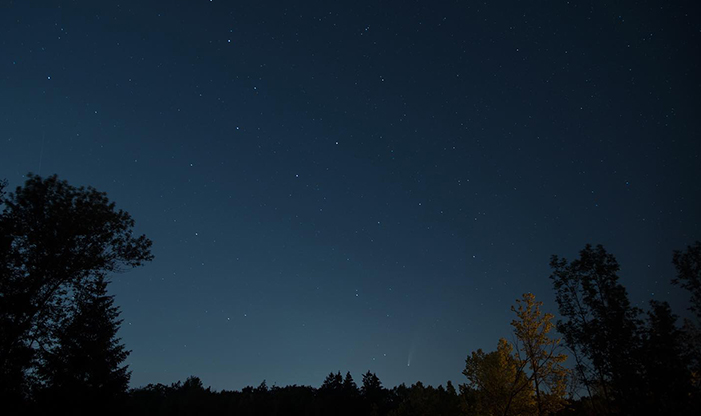This summer’s night sky is teeming with extraordinary sights. Head away from city lights and look up after dark with the naked eye, or better yet with binoculars, and you can encounter views of stars that aren’t as readily available at other times of year. You can even witness astronomical events that will occur just once in a lifetime.
Comet NEOWISE
The spectacular event of the season was the discovery and appearance of Comet NEOWISE. The comet, pictured above, streaks past the earth every 6800 years, so this was the only time it will be visible to us with only our eyes. It was discovered on March 27, 2020 from images taken by the NEOWISE space telescope. The comet passed near to the sun in July, and as it did the view of its tail became bright as the comet was heated, dispelling gas and dust from its icy surface. On July 22, it passed as close as it will come to earth’s orbit on its way back to the outer solar system, at just over 64 million miles away.
Comet NEOWISE was seen through mid-August in the northwestern sky for people living in the Northern Hemisphere. It ascended near the Big Dipper and was viewable at night around sunset when the sky was unaffected by the glare of city lights and the horizon was unobstructed. Viewers got a better view if they used binoculars to see it.
The Bright Planets of the Summer Night Sky
Jupiter, the fourth brightest object in the evening sky, was also visible with the naked eye. But with the help of binoculars, four of Jupiter’s 79 moons – Io, Europa, Ganymede, and Callisto, called the Galilean moons – could also be seen along with their mother planet. Jupiter is the largest planet in the solar system. It looks like a bright, yellow-white ‘star’ to the upper left of the constellation Sagittarius. In August, it was seen low in the east-southeast sky near dusk. It climbed higher as it became later in the evening.
Saturn was also visible to the unaided eye at night as well. Its light equals that of a first magnitude star, though it is 15 times less bright than Jupiter. It is better seen through a small telescope, however, if you would like to see its rings, as well as Titan, one of its 82 moons. Saturn is also located in Sagittarius, adjacent to the constellation Capricornus. In August, Jupiter and Saturn appear close to one another, so are easy to find in the night sky.
The Reappearance of the Perseid Meteor Shower
Meteor showers are named for their apparent point of origin, a point called its radiant. The Perseid Meteor Shower emanates from the constellation Perseus, which is how it got its name. The meteor shower peaked on August 12 and 13. It is a perennial favorite as it is the brightest meteor shower on display. Because the full moon occurred on August 3 this year, its light didn’t interfere with the view of the meteors during their peak. People hoping to see this light show needed to be prepared to sit for up to an hour, however, as meteor showers are intermittent and can take time to appear.
This meteor shower consisted of debris from the Comet 109P/Swift-Tuttle, which passes near the earth’s orbit every 133 years. The last time Swift-Tuttle passed through the inner solar system was in 1992. Every year, the earth passes through this debris. Because of this, people can see up to 100 meteors per hour in the summer night sky. This is just from what remains of the comet in the earth’s orbit.
People wishing to learn more about the night sky and locate stars, planets, and constellations may wish to download an app called Sky Guide. This phone app reveals the locations of stellar objects and helps users know in what direction to look for them. It will scan the sky and display all space objects, including those beneath the horizon.
The International Space Station
Humans have occupied the International Space Station (ISS) for almost 20 consecutive years. It is part of a multi-national program, which conducts low-gravity scientific experiments in astrobiology, astronomy, meteorology, and other fields from space. The space station orbits at an average of 250 miles above the earth. It circles the earth once every 93 minutes, or about 15 times per day. It can be seen from earth unaided by instruments and has recently been visible to Wisconsinites.
If you’d like to track the location of ISS, there are phone apps like Satellite Tracker available. It allows the user to locate the position of the station and see when it will pass close by. It also displays the view from the space station in the app.
There’s a lot to see when you look up. For visitors to learn more about the planets, stars, and constellations, we offered Summer Astronomy with Binoculars, in which Jim Hahn guided us on a tour of the spyglass menagerie found in the night sky of summer.


